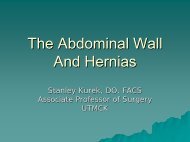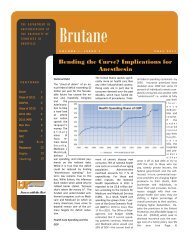Insight on the Clinical Significance of Baastrup's Disease: from ...
Insight on the Clinical Significance of Baastrup's Disease: from ...
Insight on the Clinical Significance of Baastrup's Disease: from ...
Create successful ePaper yourself
Turn your PDF publications into a flip-book with our unique Google optimized e-Paper software.
<str<strong>on</strong>g>Insight</str<strong>on</strong>g> <strong>on</strong> <strong>the</strong> <strong>Clinical</strong> <strong>Significance</strong> <strong>of</strong> Baastrup’s<br />
<strong>Disease</strong>: <strong>from</strong> Kissing Spine to Interspinous Bursitis<br />
Austin Bourgeois MD, Hunter Pears<strong>on</strong>, Patrick Barlow, Dwayne John,<br />
Ted Chang MD, and Ge<strong>of</strong>frey Laing MD<br />
Department <strong>of</strong> Radiology, Graduate School <strong>of</strong> Medicine,<br />
University <strong>of</strong> Tennessee Medical Center, Knoxville
Introducti<strong>on</strong><br />
1825: Mayer portrayed spinous<br />
processes as a source <strong>of</strong> back pain.<br />
Fluid-filled cavities interposed between<br />
adjacent lumbar spinous processes that<br />
were hypertrophied .<br />
1929: Brailsford coined <strong>the</strong> term<br />
“kissing spines”.<br />
In 1933, Christian Baastrup provided<br />
both a radiological and clinical<br />
explanati<strong>on</strong> <strong>of</strong> <strong>the</strong> syndrome. 4
Baastrup’s <strong>Disease</strong><br />
Elderly soldiers<br />
Low back pain, worsened by flexi<strong>on</strong><br />
Relieved by local anes<strong>the</strong>tic<br />
Closely approximated spinous processes<br />
Neoarthrosis<br />
Associated with “kissing spine” sign<br />
Pain generator <strong>of</strong> debated significance
Baastrup’s <strong>Disease</strong><br />
10 year old spine 50 year old spine 70 year old spine<br />
(Neo)Bursitis<br />
Neo-arthrosis
Baastrup’s <strong>Disease</strong><br />
• Lack <strong>of</strong> adequate research correlating pathologic,<br />
imaging, and clinical factors.<br />
“Kissing spine” sign (Neo)Bursitis<br />
Lateral Lumbar Spine Radiograph Sagittal Short Tau Inversi<strong>on</strong> Recovery (STIR)<br />
Sagittal Lumbar Spine MRI
“Kissing Spine” Sign Not Pathologic<br />
“…characterized by <strong>the</strong> close<br />
approximati<strong>on</strong> <strong>of</strong> adjacent spinous<br />
processes” 2<br />
“…with resultant enlargement,<br />
flattening, and reactive end plate<br />
sclerosis <strong>of</strong> <strong>the</strong> apposing<br />
interspinous surfaces” 3
Baastrup’s <strong>Disease</strong>: Research Questi<strong>on</strong>s<br />
What is <strong>the</strong><br />
prevalence?<br />
What are <strong>the</strong><br />
c<strong>on</strong>comitant<br />
pathologic findings?<br />
Is Baastrup’s disease<br />
a harbinger <strong>of</strong><br />
degenerative change<br />
elsewhere?<br />
Interspinous bursitis
Materials and Methods<br />
IRB exempti<strong>on</strong><br />
S<strong>of</strong>tek Illuminate ®<br />
862 patients with routine n<strong>on</strong>-c<strong>on</strong>trast lumbar spine MRI<br />
and:<br />
Lumbar spine CT or<br />
Lumbar spine radiograph<br />
Those with radiographic evidence <strong>of</strong> “kissing spine” were<br />
evaluated for MR evidence <strong>of</strong> interspinous bursitis.<br />
Independently reviewed by board certified radiologists.<br />
Same level degenerative disc disease (DDD), facet<br />
hypertrophy (FH), fracture, sp<strong>on</strong>dylolis<strong>the</strong>sis, and<br />
sp<strong>on</strong>dylolysis were recorded.<br />
DDD and FH were scaled as mild, moderate, or severe.
Results<br />
862 total patients<br />
103 (11.9%) had “kissing spine” changes<br />
Average age ~ 80<br />
Of <strong>the</strong>se 103 patients, 17 (16.5%) had evidence <strong>of</strong><br />
bursitis which affected 22 levels<br />
Prevalence <strong>of</strong> bursitis with fracture (24%)<br />
Prevalence without fracture (14.7%)<br />
OR for fracture <strong>of</strong> 1.84 (95% CI=.60 – 5.62), p=.357
Results<br />
• Suggesti<strong>on</strong> that bursitis is associated with less degenerative change.
Results<br />
• L3-4 and L4-5 were most comm<strong>on</strong> site (N=9)
C<strong>on</strong>clusi<strong>on</strong><br />
Demographic biased to symptomatic patients at a<br />
regi<strong>on</strong>al level 1 trauma center.<br />
Interspinous bursitis comp<strong>on</strong>ent <strong>of</strong> <strong>the</strong> Baastrup’s<br />
spectrum is present in a small proporti<strong>on</strong> <strong>of</strong> patients and<br />
likely corresp<strong>on</strong>ds with more advanced disease.<br />
Our data suggest that lumbar interspinous bursitis may<br />
be associated with a lesser degree <strong>of</strong> degenerative<br />
change.<br />
There is suggesti<strong>on</strong> <strong>of</strong> a positive correlati<strong>on</strong> between<br />
interspinous bursitis and compressi<strong>on</strong> fracture at any<br />
level, possibly related to altered lumbar spine mechanics<br />
and load-bearing.<br />
Prospective evaluati<strong>on</strong> <strong>of</strong> percutaneous corticosteroid<br />
<strong>the</strong>rapy may help to fur<strong>the</strong>r delineate clinical significance.
References<br />
Download this Presentati<strong>on</strong><br />
---> ---> and More! ---> ---><br />
1. Chen, H-J. "<strong>Clinical</strong> Experiences" Deyo RA, Tsui-Wu YJ. Descriptive epidemiology<br />
<strong>of</strong> low-back pain and its related medical care in <strong>the</strong> United States.<br />
Spine (Phila Pa 1976). 1987;12(3):264.<br />
2. Cassidy JD, Carroll LJ, Côté P. The Saskatchewan health and back pain survey.<br />
The prevalence <strong>of</strong> low back pain and related disability in Saskatchewan adults.<br />
Spine (Phila Pa 1976). 1998;23(17):1860.<br />
3. Lamer TJ, Tiede JM, Fent<strong>on</strong> DS. Fluoroscopically-Guided Injecti<strong>on</strong>s to Treat "Kissing Spine"<br />
<strong>Disease</strong>. Pain Physician 2008;11:549-554.<br />
4. Bywaters EGL, Evans S. The Lumbar Interspinous Bursae and <strong>Baastrup's</strong> Syndrome: An<br />
Autopsy Study. Rheumatology Internati<strong>on</strong>al 1982;2:87-96.<br />
5. Kw<strong>on</strong>g Y, Nitin R, Latief K. MDCT Findings in <strong>Baastrup's</strong> <strong>Disease</strong>: <strong>Disease</strong> or Normal Feature<br />
<strong>of</strong> <strong>the</strong> Aging Spine? AJR 2011; 196:1156-1159.<br />
6. Meleger AL, Krivickas LS. Neck and Back Pain: Musculoskeletal Disorders. Neurological<br />
Clinics 2007; 25:419-438.<br />
7. Rajasekaran S, Pithwa YK. <strong>Baastrup's</strong> <strong>Disease</strong> as a Cause <strong>of</strong> Neurogenic Claudicati<strong>on</strong>.<br />
SPINE 2003;28(14):273-275.<br />
8. Maes R, Morris<strong>on</strong> WB, Parker L, Schweitzer ME, Carrino JA. Lumbar Interspinous Bursitis<br />
(<strong>Baastrup's</strong> <strong>Disease</strong>) in a Symptomatic Populati<strong>on</strong>. SPINE 2008;33(7):211-215.<br />
9. Haig AJ, Harris A, Quint DJ. <strong>Baastrup's</strong> <strong>Disease</strong> Correlating with Diffuse Lumbar Paraspinal<br />
Atrophy: A Case Report. Archive Physical Medicine Rehabilitati<strong>on</strong> 2001;82:250-252.<br />
10.Depalma MJ, Slipman CW, Siegelman E, et al. Interspinous Bursitis in an Athlete. Journal <strong>of</strong><br />
B<strong>on</strong>e & Joint Surgery (Br) 2004;86-B:1062-1064.<br />
11.Mitra R, Ghazi U, Kirpalani D, Cheng I. Interspinous Ligament Steroid Injecti<strong>on</strong> for <strong>the</strong><br />
Management <strong>of</strong> Baastrup’s <strong>Disease</strong>: A Case Report. Archive Physical Medicine Rehabilitati<strong>on</strong><br />
2007;88(10):1353-1356.




